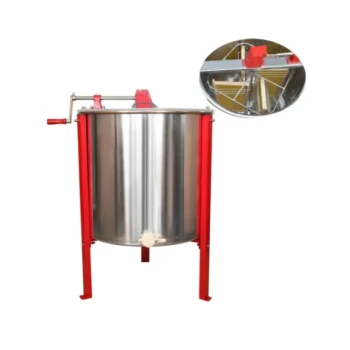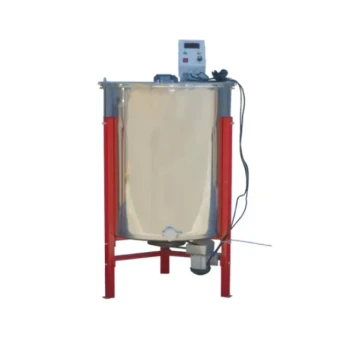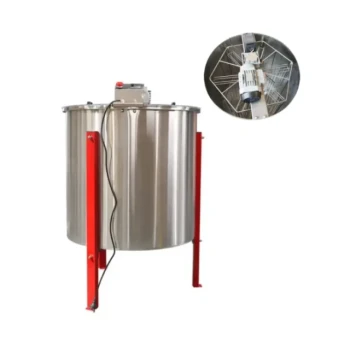On average, centrifuging a set of honey frames takes just 2 to 4 minutes per side. This time varies based on the type of extractor, the speed of the spin, and the temperature of the honey. Achieving a clean extraction without damaging the delicate beeswax comb requires a strategic approach, not just raw speed.
The objective of honey extraction is not simply to be fast, but to be efficient and gentle. A successful spin relies on a gradual increase in speed to remove the maximum amount of honey while preventing the force from breaking the fragile combs, especially when they are heavy and full.
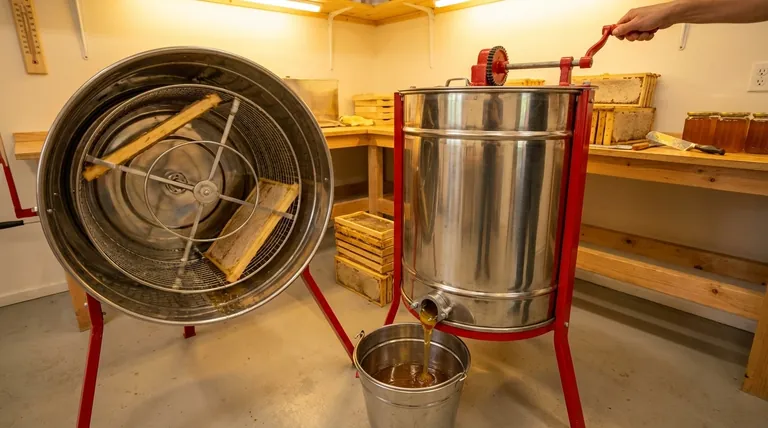
The Principle of Centrifugal Extraction
To understand the timing, you must first understand the goal. The extractor uses centrifugal force to sling honey out of the hexagonal wax cells where the bees have stored it.
The Role of Centrifugal Force
As the frames spin, the honey, which is heavy and liquid, is pushed outward against the wall of the extractor drum. It then runs down the walls and collects at the bottom, where it can be drained through a gate.
Why Gradual Speed is Crucial
A frame full of honey is heavy. If you begin spinning at maximum speed immediately, the immense weight of the honey can shatter the comb structure against the frame's foundation. Starting slowly allows some honey to be extracted, lightening the comb before higher speeds are applied.
Factors That Determine Extraction Time
The "2 to 4 minute" rule is a guideline. The ideal time for your specific situation depends on several key variables that you control.
Extractor Type
The single biggest factor is whether your extractor is tangential or radial.
- Tangential Extractors hold frames like spokes in a wheel, with one side of the comb facing out. You must spin one side, stop, flip the frames, and then spin the other side. This process inherently takes more active time.
- Radial Extractors hold frames so the top bar faces the outer wall. Force is applied to both sides of the comb simultaneously, extracting honey from both sides at once without the need for flipping.
Honey Temperature and Viscosity
Warm honey is less viscous (thinner) and flows much more easily. Extracting in a warm room (85-95°F or 30-35°C) can significantly reduce the time needed to spin the honey out of the cells. Cold honey is thick and requires much more time and force to extract.
Fullness and Weight of the Comb
Extremely full, heavy combs are the most fragile. They require a slower initial spin to prevent "blowouts," where the comb structure detaches from the foundation and is destroyed.
Understanding the Trade-offs
Optimizing your extraction process involves balancing competing priorities. Knowing the trade-offs is key to making the right decision for your operation.
Speed vs. Comb Integrity
This is the most critical trade-off. Rushing the process by starting at a high speed is the number one cause of damaged comb. Destroyed comb costs the bees an enormous amount of energy and resources to rebuild, which reduces your next honey crop.
Time vs. Yield
Not spinning long enough will leave a significant amount of honey in the combs. While this isn't harmful, it lowers your harvest yield. Conversely, spinning for an excessive amount of time yields diminishing returns and is an inefficient use of your time and energy.
A Practical Spinning Process
Instead of focusing on a timer, follow a process based on results. This example is for a common tangential extractor.
Step 1: The Initial Slow Spin
Load the uncapped frames. Spin at a low speed for about 2 minutes. The goal here is not to empty the comb, but to extract about 40-50% of the honey. This significantly lightens the frames.
Step 2: Flip and Increase Speed
Stop the extractor, flip the frames so the un-extracted side now faces out, and restart the spin. Because the initial side is now partially empty, the comb is much more stable. You can now spin at a higher speed for 2-4 minutes to fully extract this second side.
Step 3: The Final High-Speed Spin
Flip the frames one last time to their original position. The combs are now very light and can handle a final, high-speed spin for 1-2 minutes to remove the remaining honey from the first side.
For a radial extractor, the process is simpler: start slow for a few minutes, then gradually ramp up the speed until the honey stops flowing, with no flipping required.
Making the Right Choice for Your Goal
Your approach should align with your primary objective as a beekeeper.
- If your primary focus is preserving pristine comb for reuse: Always err on the side of caution by starting slow and gradually increasing speed, even if it takes a few extra minutes per load.
- If your primary focus is maximizing speed and harvest yield: Ensure the extraction room is very warm to decrease honey viscosity and use a radial extractor if possible to eliminate time spent flipping frames.
Ultimately, mastering honey extraction is about observing your results and listening to your equipment, not just watching the clock.
Summary Table:
| Factor | Impact on Extraction Time |
|---|---|
| Extractor Type | Radial is faster (no flip); Tangential requires flipping, adding time. |
| Honey Temperature | Warm honey (>85°F/30°C) flows faster, reducing time; cold honey slows it down. |
| Comb Fullness | Heavy, full combs require a slower start to prevent damage, slightly increasing time. |
| Spin Speed | Gradual speed increase is safer; starting fast risks comb blowout but is quicker. |
Ready to Optimize Your Honey Harvest?
Maximizing honey yield while preserving your valuable comb requires the right equipment. HONESTBEE supplies durable, high-performance honey extractors and essential beekeeping supplies to commercial apiaries and distributors.
We help you:
- Increase Efficiency: Our radial and tangential extractors are designed for smooth, effective extraction.
- Protect Your Investment: Quality equipment minimizes comb damage, saving your bees time and energy.
- Scale Your Operation: Reliable, wholesale-focused supplies support your growth.
Contact HONESTBEE today to discuss the best extraction solutions for your commercial beekeeping needs.
Visual Guide
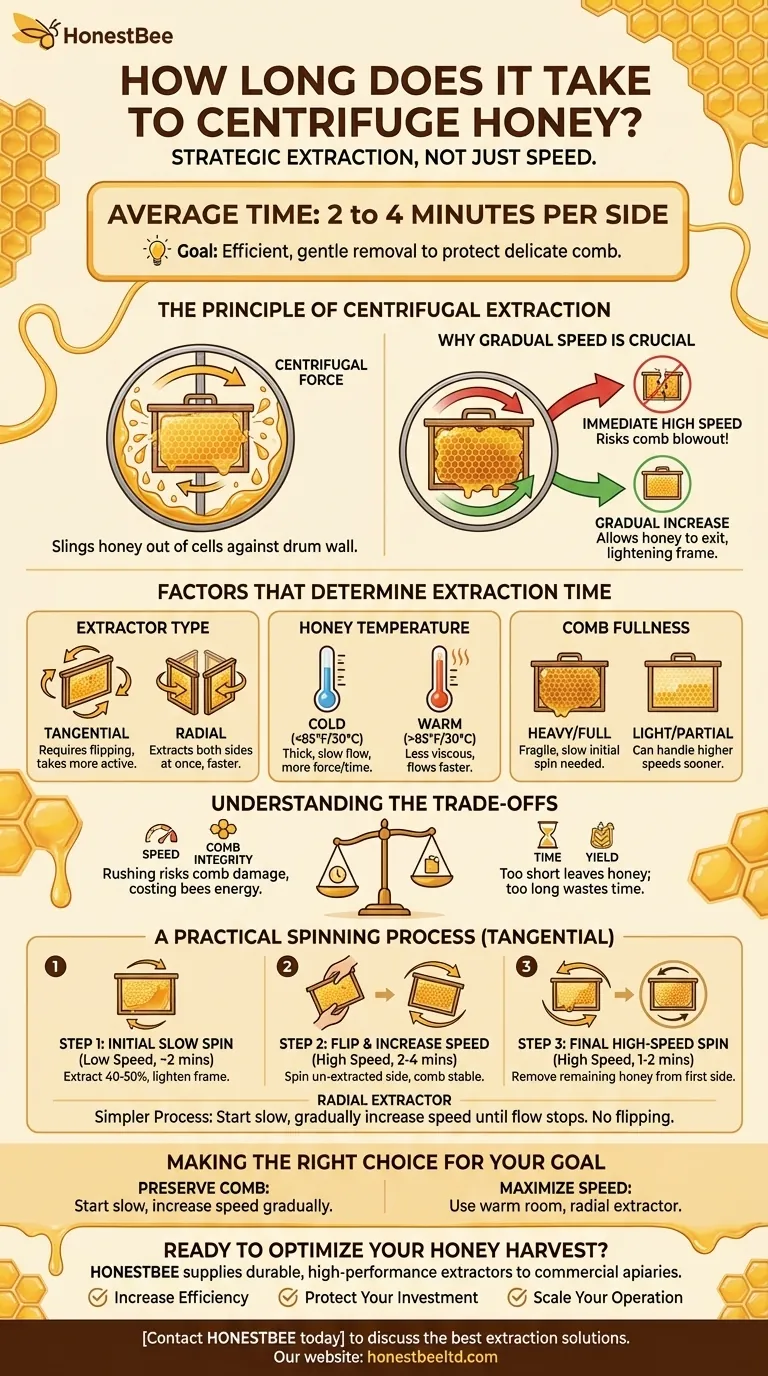
Related Products
- 2 Frame Stainless Steel Manual Honey Spinner Extractor for Beekeeping
- Electric 8 Frame Honey Spinner Extractor Equipment for Beekeeping
- Stainless Steel Manual 8 Frame Radial Honey Extractor Machine for Beehives
- HONESTBEE 4 Frame Manual Self Reversing Honey Extractor for Beekeeping
- 8-Frame Electric Self-Reversing Honey Extractor Spinner for Commercial Honey Extraction Equipment
People Also Ask
- What are the advantages of tangential honey extractors? Gentle, Affordable Honey Extraction for Your Apiary
- Can a manual extractor be upgraded to an electric one? Save Labor & Boost Efficiency
- How does centrifugation work in honey extraction? The Sustainable Method for Modern Beekeepers
- What are some expert tips for cleaning a honey extractor? Protect Your Harvest & Equipment
- How can a pressure washer be used to clean a honey extractor? A Guide to Safe and Efficient Cleaning



